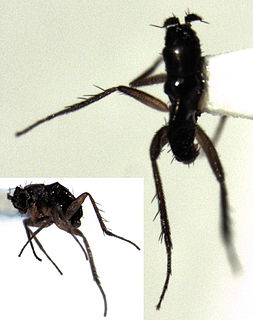
Dolichopodidae, the long-legged flies, are a large, cosmopolitan family of true flies with more than 7,000 described species in about 230 genera. The genus Dolichopus is the most speciose, with some 600 species.

Hybotidae, the typical dance flies, are a family of true flies. They belong to the superfamily Empidoidea and were formerly included in the Empididae as a subfamily.
Acropsilus is a genus of flies in the family Dolichopodidae. It is unplaced in the family, having been placed variously in subfamilies such as Sympycninae or Peloropeodinae. It is superficially similar to the Medeterinae.
Antyx is a genus of flies in the family Dolichopodidae from the Australasian realm. The genus was originally placed in the subfamily Sympycninae, but it was later found to be closer to the Neurigoninae and was placed as incertae sedis within the family. In the World Catalog of Dolichopodidae by Yang et al. (2006), the new subfamily Antyxinae was proposed, in which Antyx is the only genus. However, the validity of this new subfamily was later criticized by Sinclair et al. (2008). According to them, the subfamily's erection by Yang et al. (2006) was not justified by their phylogenetic analysis, and the genus would have been better placed as incertae sedis until a later phylogenetic study determines its placement.

Asyndetus is a genus of flies in the family Dolichopodidae. There are more than 100 species described for the genus, distributed worldwide.
Kowmungia is a genus of flies in the family Dolichopodidae. It is known from Australia.
Phacaspis is a genus of flies in the family Dolichopodidae. It is known from Southeast Asia and Papua New Guinea. Flies in the genus are small, with metallic green coloring. They are marine, and are commonly found on mudflats in front of mangroves.

Teuchophorus is a genus of flies in the family Dolichopodidae.
Thinolestris is a genus of fly in the family Dolichopodidae.

Thinophilus is a genus of flies in the family Dolichopodidae.
Urodolichus is a genus of fly in the family Dolichopodidae. It is known from the Afrotropical realm, Indomalayan realm and Australasian realm. It has been placed in either Rhaphiinae or Diaphorinae, though Grichanov & Brooks (2017) consider the genus to be incertae sedis within the family Dolichopodidae.

Hydrophorinae is a subfamily of flies in the family Dolichopodidae. According to Germann et al. (2011), the subfamily is polyphyletic.

Achalcinae is a subfamily of flies in the family Dolichopodidae. It is an ancestral group close to Medeterinae and Sciapodinae.

Dolichopodinae is a subfamily of flies in the family Dolichopodidae.

Medeterinae is a subfamily of flies in the family Dolichopodidae.

Peloropeodinae is a subfamily of flies in the family Dolichopodidae. According to Germann et al. (2011), the subfamily is polyphyletic.

Sympycninae is a subfamily of flies in the family Dolichopodidae.

Rhaphiinae is a subfamily of flies in the family Dolichopodidae.
Griphophanes is a genus of flies in the family Dolichopodidae. It is known from Southeast Asia and the Democratic Republic of the Congo in Central Africa.











